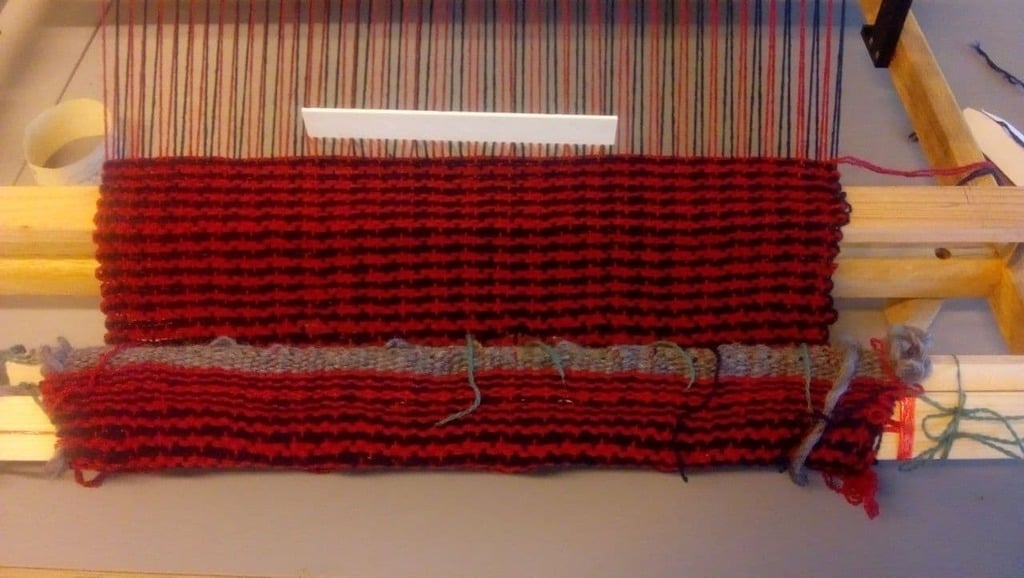
Split Reed Rigid Heddle Loom
thingiverse
This is a simple Ridgid Heddle loom, where the reed can split open to allow for easy warping/stringing. The simple design is my own, I have never seen a "split reed loom" before, but I doubt that I am the first one to come up with this, as the idea is so simple. Oh did I mention that all the complicated parts are 3d printed? Why split the reed? If you split the reed open (see pictures above) you can warp/string the loom by just laying the threads where you want them to, quickly change your threading pattern, and fix mistakes. After you are done, you can secure/close the reed again with two bolts or screws. How big is the loom? The loom is infinitely expandable in width, and the depth is whatever you want it to be. The loom that I've built is 1 meter wide, and 80 cm deep. It uses eight 6 mm reeds, 4 on the bottom and 4 on the top of the reed. It can make a fabric that is up to ~80 cm wide, depending on how you use the loom. Which reed should I pick? There are 3 reeds so far, 6 mm, 5 mm and 4 mm. I've only used the 6 mm so far, which is good for carpets, but too rough for fabric. I would recommend the 4 mm reeds, or 5 mm reeds. I have tried making 3 mm reeds, but those are quite finicky to get to align, and don't really work with this split design yet. What type of thread should be used? Depends on what you are doing, but generally your thread type goes together with your reed size. The 6 mm reed works well with threads that are 50 meters per 50 grams, or thicker. The 4 mm reed would probably use a thread that is 75 to 100 meters per 50 grams. What type of pattern does this loom weave in? This loom can only do a plain weave, the yee-olde up-under-up-under weave. That is because it only has one reed. A multi reed system is designed, but needs to be tested before uploading, which will happen after new-years. Are all parts of this loom 3D printed? No, you will have to add some wooden parts, or aluminium, or steel, or plastic. There are some bigger pieces in the design, that just don't make sense to 3d print. All the extra parts are straight, and either square or round. What extra materials do I need to make the loom? Depends on the size and reed size. I assume you would use wood for this example. You will have to decide how many reed parts you want to print, and measure it's width. Then you add 6 cm to that, this is the length of the wooden parts of your reed. add 0,5 cm to that, this is the length of the horizontal braces of the loom, and the length of the rollers that hold the fabric. Then you add 6-10 cm to the previous measurement, depending on what you use to make the loom, and that would be the length of the armrests on either side of the loom. The side pieces of the loom, can be as long or short as you want them to be, I would recommend between 60 en 80 cm. Then there are some feet, and some and some separator pieces, which can be 3D printed or made out of wood. The last and most important bit, are 4 pieces of threaded rod that have to be inserted into the rollers, and glued with epoxy. I used 16 mm axles, that I turned on the lathe, but M10, M12 or M16 threaded rod, in 4 pieces of 15 cm, should do the job fine. You need to print the gears and axle holders that fit with your choice of threaded rod. So in short: 3D printed parts screws/M3 bolts and nuts glue (5 minute epoxy) building materials (example: wood: 40*40 mm (main frame, rollers), 10*10 mm (reed and front/back stick, 10*40 mm (front/back rests) threaded rods (M10, M12 or M16) paint/oil to finish the loom String, and threads to make fabric a shuttle (or two) to weave the fabric
With this file you will be able to print Split Reed Rigid Heddle Loom with your 3D printer. Click on the button and save the file on your computer to work, edit or customize your design. You can also find more 3D designs for printers on Split Reed Rigid Heddle Loom.
